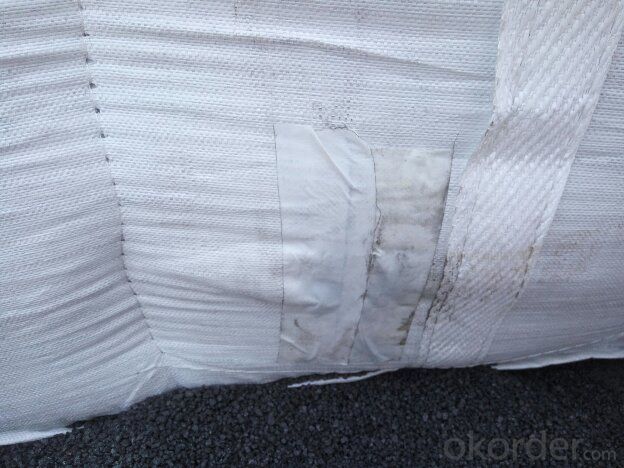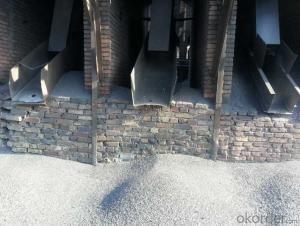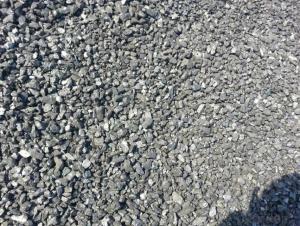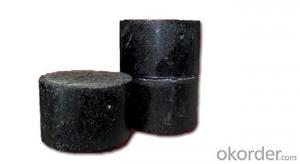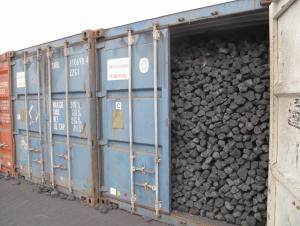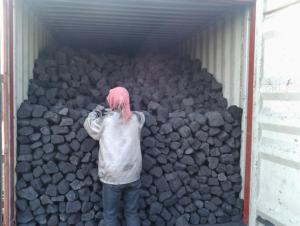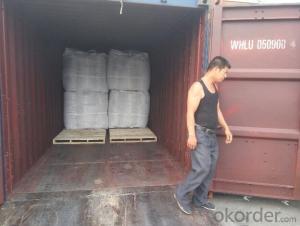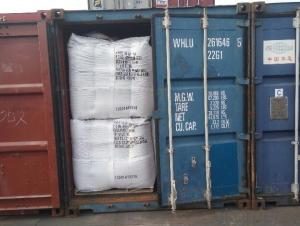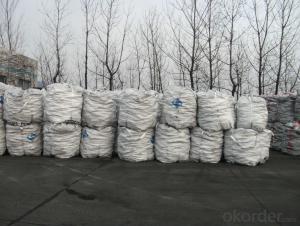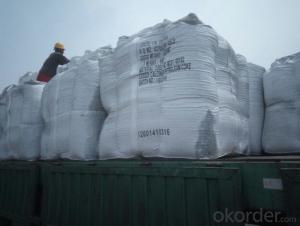10% Ash Foundry Coke with Mositure 5%max
- Loading Port:
- Shanghai
- Payment Terms:
- TT OR LC
- Min Order Qty:
- 20.4
- Supply Capability:
- 1004 m.t./month
OKorder Service Pledge
OKorder Financial Service
You Might Also Like
Brief Introduction
Foundry Coke is the main fuel of melting iron in the oven. It can melt the materials in the over, make the iron reach great heat, and keep good air permeability by sustain stock column. Thus, the foundry coke should have the characteristics of big block, low reactivity, small porocity, enough anti-crush strengh, low ash and low sulphur.
The coke handled by our cooperation is made from superior coking coal of Shanxi province. Provided with the advantages of low ash, low sulphur and high carbon. Our coke is well sold in European, American, Japanese and South-east Asian markets. Our owned Coke plant are located in Shanxi Province and supplying of you many kinds of coke.
we supply Foundry Coke long-term, its characteristic is best strength, low sulfur and phosphorus,thermal stability.
Specifications:
ASH % | 8% max | 10% max | 12% max |
V.M.% MAX | 1.5% max | 1.5% max | 2% max |
SULFUR % | 0.65% max | 0.65% max | 0.7% max |
MOISTURE | 5% max | 5% max | 5% max |
Size | 80mm-120mm,80-150,100-150mm, or as request | ||
Features
1. Our quality is always quite good and stable which is producing and packing according to customers' requirements.
2. Putting Client profile into first, achieved mutual benefit.It is more and more widely-used
3. Good partner on business. It's a good and wise choice for customers' to purchase from us. It's our great honor to cooperate with you.
4. We can supply documents as follows:
- bill of loading,
-Invoice,
-Packing List
-Insurance
-standard inspection pictures of the container as specified by INSPECTORATE
-or more requested by buyer.
Pictures

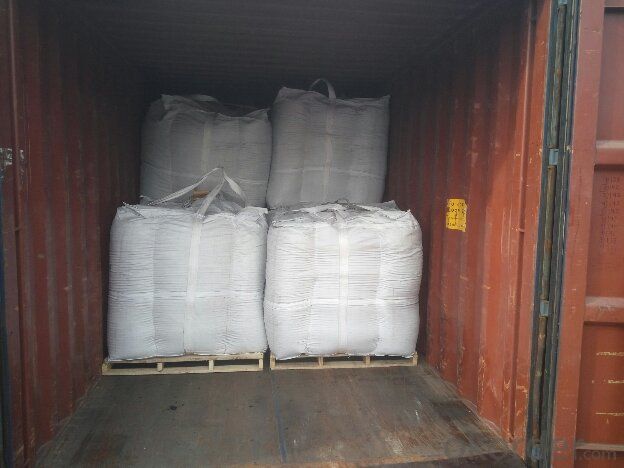
FAQ
1. What is the packing?
In 25kg bag/ In jumbo bags without pallet/ Two jumbo bags with one pallet/ or as customers’ request
2. What is the production capacity?
10 thousand tons per month
3 What is payment term?
Irrevocable LC at sight/ 20% down payment by T/T and 80% against BL copy byT/T/ or to be discussed
4 What is the service?
We will send sample to the third party(CIQ, CCIC, SGS,BV or to be discussed) for checking, and present the test certificate and loading repot of shipment.
- Q: Is carbon a conductor?
- Carbon is an element, not an organization, and when the carbon atoms are arranged in different spatial forms, the physical and chemical properties of the substances formed are different. When the formation of lamellar material carbon atom with six ring as a unit, the material is a conductor, which is familiar to us when graphite, carbon atoms to form a tetrahedral structure, which is macroscopically when diamond is an insulator. There are many forms of carbon elements, which are not listed in one by one
- Q: How does carbon affect the taste of food and beverages?
- Carbon can affect the taste of food and beverages by either enhancing or altering their flavor profiles. In the case of carbonated beverages, the added carbon dioxide creates a bubbly sensation, which can give a refreshing and lively mouthfeel. Carbonation also enhances the perception of acidity and can balance the sweetness in some drinks. On the other hand, when carbon-based compounds, such as those found in charred or grilled food, come into contact with heat, they can create smoky or burnt flavors that add depth and complexity to certain dishes. Overall, carbon plays a significant role in influencing the taste and sensory experience of various food and beverage products.
- Q: How is carbon used in the production of plastics?
- Carbon is used in the production of plastics through a process called polymerization. Carbon atoms are linked together to form long chains or networks known as polymers, which give plastics their characteristic properties. These carbon-based polymers can be molded into various shapes and sizes to create a wide range of plastic products that are used in our daily lives.
- Q: What is the carbon content of different types of soil?
- Various factors, such as climate, vegetation, and land management practices, can greatly influence the carbon content of different types of soil. Generally, soils with higher levels of organic matter exhibit higher levels of carbon. For instance, peat soils boast the highest carbon content among all soil types, ranging from 30% to 60%. These soils form in wetland areas where the decomposition of organic matter is hindered by water saturation, resulting in the accumulation of substantial amounts of carbon over time. Forest soils also tend to possess relatively high carbon content, typically falling between 1% and 10%. Forests continually supply organic matter through litterfall, contributing to the build-up of carbon in the soil. In contrast, agricultural soils generally exhibit lower carbon content compared to peat or forest soils. Factors such as crop rotation, organic amendments, and tillage practices influence the carbon content of agricultural soils. Consequently, the carbon content in these soils can range from less than 1% to around 6%. Grassland soils may have carbon contents similar to agricultural soils, depending on management practices. However, in undisturbed grasslands with high plant productivity, the carbon content can be relatively higher, ranging from 2% to 8%. In arid and desert regions, soils tend to display lower carbon content due to limited vegetation and slower rates of organic matter decomposition. Typically, the carbon content in these soils is less than 1%. It is important to acknowledge that these ranges are generalizations, and the carbon content of soil can vary both within and between soil types. Additionally, alterations in land use, such as deforestation or the conversion of grasslands to agriculture, can have a significant impact on soil carbon content.
- Q: What are the challenges of carbon capture and storage technology?
- One of the main challenges of carbon capture and storage technology is the high cost involved in implementing and maintaining the infrastructure. The capturing and storing of carbon dioxide emissions requires significant investment in equipment and facilities, making it financially burdensome for many industries. Additionally, the process of capturing carbon dioxide from flue gases can consume a considerable amount of energy, resulting in increased operational costs. Another challenge is the limited capacity for storing captured carbon dioxide. Finding suitable geological formations or reservoirs to safely store large quantities of carbon dioxide is a complex and time-consuming task. It requires thorough geological assessments and monitoring to ensure that the stored carbon dioxide will not leak back into the atmosphere or pose any environmental risks. Moreover, the transportation of captured carbon dioxide to storage sites can also be a logistical challenge. Developing a robust and efficient transportation infrastructure to move carbon dioxide from various emission sources to storage locations is crucial but can be difficult, especially in areas with limited existing infrastructure. Furthermore, there are concerns about the long-term security and permanence of stored carbon dioxide. It is essential to ensure that the stored carbon dioxide remains trapped underground indefinitely to prevent its release into the atmosphere. This requires continuous monitoring and verification processes to guarantee the integrity of the storage sites over extended periods. Lastly, public acceptance and regulatory frameworks pose significant challenges for carbon capture and storage technology. There may be public concerns about the safety and potential environmental impacts of storing large amounts of carbon dioxide underground. Establishing clear regulations and guidelines, as well as effective communication and public engagement, are essential to address these concerns and build trust in the technology.
- Q: How do you use carbon fourteen to measure the age?
- Then, carbon - 14 dating method is to determine the remains of ancient age? Originally, cosmic rays can produce radioactive carbon -- 14 in the atmosphere, and can enter all living tissue carbon dioxide and oxygen - synthesis combined, first for the absorption of plants, after the animal into a plant or animal. As long as they live. Continuous absorption of carbon - 14, to maintain a certain level in the body. When the organism dies, which will stop breathing carbon - 14, within their organization, with a half-life of 14 carbon began 5730 years of decay and gradually disappear. For any carbon containing material, as long as the determination of the remaining 14 of the content of radioactive carbon you can, that the age of 14. Carbon dating method is divided into conventional carbon - 14 dating method and carbon - 14 accelerator mass spectrometry dating two. At that time, since it is invented by Libby conventional carbon - 14 dating method, this 1950. The technology and application of methods have significant progress in the world, but its limitations are obvious, namely the time measurement must use a large number of samples and longer. Thus, carbon - 14 dating accelerator mass spectrometry technology developed. Carbon - 14 accelerator mass spectrometry dating method has unique advantages.
- Q: What is carbon nanocomposite?
- A carbon nanocomposite is a material that combines carbon nanotubes or graphene with a matrix material like polymers or metals to form a composite material. Usually, small amounts of carbon nanotubes or graphene, often in the form of nanoparticles, are added to improve the mechanical, electrical, and thermal properties of the composite material. Carbon nanotubes are cylindrical structures made of carbon atoms arranged in a hexagonal lattice, while graphene is a single layer of carbon atoms arranged in a two-dimensional lattice. These carbon-based materials have exceptional properties, such as high strength, electrical conductivity, and thermal conductivity. When incorporated into a composite material, these properties can be transferred to the overall structure, resulting in improved performance. Various industries and applications have explored the use of carbon nanocomposites. For instance, in aerospace, researchers have investigated these materials for their lightweight and high-strength properties, which could potentially enhance the fuel efficiency and durability of aircraft components. In electronics, carbon nanocomposites show promise for developing high-performance sensors, conductive films, and energy storage devices. Moreover, they have been studied for potential applications in medical devices, automotive parts, and energy storage systems. In summary, carbon nanocomposites offer the opportunity to create materials with enhanced properties by leveraging the unique characteristics of carbon nanotubes or graphene. However, challenges in production and scalability still exist, and further research is needed to optimize their performance and cost-effectiveness for various applications.
- Q: How is carbon used in the steel industry?
- Carbon is used in the steel industry as an essential element for the production of steel. It is added to iron during the steelmaking process to increase the strength and hardness of the final product. By controlling the carbon content, different types of steel with varying properties can be produced, such as high carbon steel for tools or low carbon steel for structural applications.
- Q: How does carbon impact the productivity of marine ecosystems?
- Marine ecosystems are greatly affected by carbon, impacting their productivity in various ways. One significant effect is seen through ocean acidification. When human activities release carbon dioxide into the atmosphere, a considerable portion is absorbed by the oceans. This excess carbon dioxide reacts with seawater, producing carbonic acid and causing a decrease in the ocean's pH. This rise in acidity has harmful consequences for numerous marine organisms, particularly those relying on calcium carbonate for their shells or skeletons, such as corals, shellfish, and certain plankton species. Ocean acidification hinders calcification, making it challenging for these organisms to develop and maintain their protective structures. This not only affects their survival but also has repercussions for the entire food chain. Many species depend on these calcium carbonate structures for food or shelter, so a decline in their productivity can have a cascading impact on the ecosystem. Moreover, heightened carbon dioxide levels in the ocean can also disrupt the metabolism and physiology of marine organisms. Some studies indicate that increased CO2 concentrations can impede the growth, development, and reproductive success of specific species. Consequently, overall productivity within the ecosystem decreases. Furthermore, marine ecosystems are also affected by climate change, which is fueled by the accumulation of carbon dioxide in the atmosphere. Rising temperatures disrupt the delicate balance of these ecosystems, altering the distribution and abundance of species, changing predator-prey dynamics, and causing shifts in the timing of crucial ecological events like spawning or migration. These changes have profound effects on the productivity of marine ecosystems, as different species struggle to adapt or compete under new conditions. In conclusion, carbon dioxide emissions have far-reaching consequences for marine ecosystems. Ocean acidification and climate change, both driven by excessive carbon dioxide, harm the productivity of marine ecosystems by impacting the growth, survival, and reproductive success of marine organisms. The effects of carbon on marine ecosystems underscore the urgent necessity to reduce greenhouse gas emissions and mitigate the impacts of climate change in order to protect these delicate and essential ecosystems.
- Q: How can Dungeon Fighter Online's superior furnace rock carbon be obtained?
- DNF advanced furnace carbon can acquire rock at the mall, priced at 450 points and 50 points 10 coupon coupon 1.The role is to use advanced furnace rock carbon can start at the Kylie advanced equipment reinforcement machine, strengthen the probability of success is greater!Point Keri election advanced strengthening, plus ten or more equipment to strengthen, the probability is 10% more than ordinary furnace carbon
Send your message to us
10% Ash Foundry Coke with Mositure 5%max
- Loading Port:
- Shanghai
- Payment Terms:
- TT OR LC
- Min Order Qty:
- 20.4
- Supply Capability:
- 1004 m.t./month
OKorder Service Pledge
OKorder Financial Service
Similar products
Hot products
Hot Searches



